3a Getting Started with Arduino and Genuino UNO PDF

| Title | 3a Getting Started with Arduino and Genuino UNO |
|---|---|
| Author | Tuấn Đoàn |
| Course | Internet of Things |
| Institution | FPT University |
| Pages | 9 |
| File Size | 906.7 KB |
| File Type | |
| Total Downloads | 37 |
| Total Views | 159 |
Summary
Internet Vạn Vật, hay cụ thể hơn là Mạng lưới vạn vật kết nối Internet hoặc là Mạng lưới thiết bị kết nối Internet (tiếng Anh: Internet of Things, viết tắt IoT) là một liên mạng, trong đó các thiết bị, phương tiện vận tải (được gọi là "thiết bị kết nối" và "thiết bị thông minh"), phòng ốc và các tra...
Description
Getting Started with Arduino and Genuino UNO This document explains how to connect your Uno board to the computer and upload your first sketch. The Arduino Uno is programmed using the Arduino Software (IDE), our Integrated Development Environment common to all our boards and running both online and offline.
Use your Arduino/Genuino Uno on the Arduino Web IDE All Arduino and Genuino boards, including this one, work out-of-the-box on the Arduino Web Editor, no need to install anything. The Arduino Web Editor is hosted online, therefore it will always be up-to-date with the latest features and support for all boards.
Use your Arduino/Genuino Uno on the Arduino Desktop IDE If you want to program your Arduino/Genuino Uno while offline you need to install the Arduino Desktop IDE The Uno is programmed using the Arduino Software (IDE), our Integrated Development Environment common to all our boards. Before you can move on, you must have installed the Arduino Software (IDE) on your PC, as explained in the home page of our Getting Started. Connect your Uno board with an A B USB cable; sometimes this cable is called a USB printer cable
The USB connection with the PC is necessary to program the board and not just to power it up. The Uno automatically draw power from either the USB or an external power supply. Connect the board to your computer using the USB cable. The green power LED (labelled PWR) should go on.
Install the board drivers If you used the Installer, Windows - from XP up to 10 - will install drivers automatically as soon as you connect your board. If you downloaded and expanded the Zip package or, for some reason, the board wasn't properly recognized, please follow the procedure below.
Click on the Start Menu, and open up the Control Panel. While in the Control Panel, navigate to System and Security. Next, click on System. Once the System window is up, open the Device Manager.
Look under Ports (COM & LPT). You should see an open port named "Arduino UNO (COMxx)". If there is no COM & LPT section, look under "Other Devices" for "Unknown Device". Right click on the "Arduino UNO (COmxx)" port and choose the "Update Driver Software" option.
Next, choose the "Browse my computer for Driver software" option.
Finally, navigate to and select the driver file named "arduino.inf", located in the "Drivers" folder of the Arduino Software download (not the "FTDI USB Drivers" sub-directory). If you are using an old version of the IDE (1.0.3 or older), choose the Uno driver file named "Arduino UNO.inf"
Windows will finish up the driver installation from there.
Open your first sketch Open the LED blink example sketch: File > Examples >01.Basics > Blink.
Select your board type and port You'll need to select the entry in the Tools > Board menu that corresponds to your Arduino or Genuino board.
Select the serial device of the board from the Tools | Serial Port menu. This is likely to be COM3 or higher (COM1 and COM2 are usually reserved for hardware serial ports). To find out, you can disconnect your board and re-open the menu; the entry that disappears should be the Arduino or Genuino board. Reconnect the board and select that serial port.
Upload the program Now, simply click the "Upload" button in the environment. Wait a few seconds - you should see the RX and TX leds on the board flashing. If the upload is successful, the message "Done uploading." will appear in the status bar.
A few seconds after the upload finishes, you should see the pin 13 (L) LED on the board start to blink (in orange). If it does, congratulations! You've gotten Arduino or Genuino up-and-running....
Similar Free PDFs
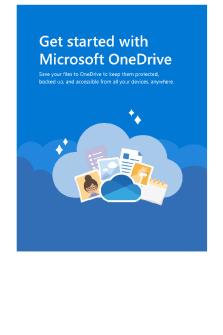
Getting started with One Drive
- 5 Pages
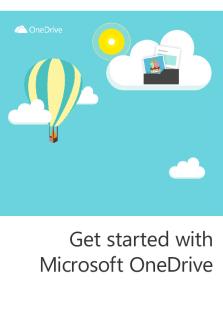
Getting started with One Drive
- 9 Pages
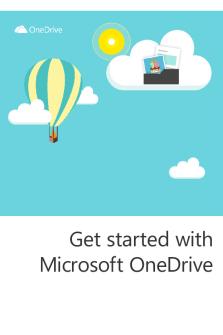
Getting started with One Drive
- 9 Pages

Getting Started with Tally.ERP 9
- 185 Pages
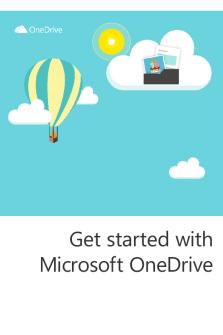
Getting started with One Drive
- 9 Pages

Getting started with One Drive
- 4 Pages

Getting Started with Native Script
- 168 Pages
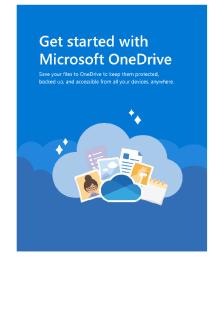
Getting started with One Drive
- 5 Pages

Getting started with One Drive
- 1 Pages

Getting Started with Brand Pro
- 36 Pages

Getting Started
- 6 Pages
Popular Institutions
- Tinajero National High School - Annex
- Politeknik Caltex Riau
- Yokohama City University
- SGT University
- University of Al-Qadisiyah
- Divine Word College of Vigan
- Techniek College Rotterdam
- Universidade de Santiago
- Universiti Teknologi MARA Cawangan Johor Kampus Pasir Gudang
- Poltekkes Kemenkes Yogyakarta
- Baguio City National High School
- Colegio san marcos
- preparatoria uno
- Centro de Bachillerato Tecnológico Industrial y de Servicios No. 107
- Dalian Maritime University
- Quang Trung Secondary School
- Colegio Tecnológico en Informática
- Corporación Regional de Educación Superior
- Grupo CEDVA
- Dar Al Uloom University
- Centro de Estudios Preuniversitarios de la Universidad Nacional de Ingeniería
- 上智大学
- Aakash International School, Nuna Majara
- San Felipe Neri Catholic School
- Kang Chiao International School - New Taipei City
- Misamis Occidental National High School
- Institución Educativa Escuela Normal Juan Ladrilleros
- Kolehiyo ng Pantukan
- Batanes State College
- Instituto Continental
- Sekolah Menengah Kejuruan Kesehatan Kaltara (Tarakan)
- Colegio de La Inmaculada Concepcion - Cebu




